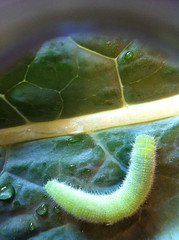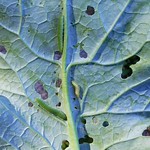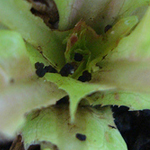 By Justin Emig
By Justin Emig
Associate Brand Manager, Safer Brand
For most of the country, Spring has DEFINITELY sprung…
…and with the onset of Spring, comes the onset of our unwelcome garden pests.
The garden pest that has caused the most concern for organic gardeners in recent years has been the cabbage worm.
There are several ‘types’ of cabbage worm which include the Imported Cabbage Worm, Cabbage Looper, Cabbage Webworm, and the Leaf Miner.
Regardless of the type, us interested in keeping an organic garden just want them gone!! Here are 5 signs that you might be infested with our green pests and best of all, how to get rid of these ferocious vegetable eaters.
Here are 5 signs that your garden might be infested with cabbage worms. — Tweet This.
Signs you have cabbage worms
1. You are growing their favorite food
As you can guess from their name, cabbage worms primarily attack plants in the cabbage family, but are not exclusively cabbage feeders. Plants that cabbage worms find the most tasty are:
- Broccoli
- Cauliflower
- Brussels sprouts
- Collards
- Kale
- Turnip greens
- Radishes
- Other cabbage greens
 2. You have holes in your plants
2. You have holes in your plants
Since cabbage worms are such voracious eaters, as little as 2 or 3 worms on your plants can spell disaster for the overall health of your broccoli or other plant.
Common signs will be holes in your leaves. A simple google search can connect you to many pictures of cabbage worm damage.
 3. You notice dark green droppings on your leaves
3. You notice dark green droppings on your leaves
A tell-tale sign that you are becoming infested with cabbage worms are their droppings. When you start to notice dark green droppings on your leaves, inspect the underside of your leaves as that is where cabbage worms tend to lay their eggs.
4. A lot more butterflies present
Since caterpillars are in essence the larvae stage of caterpillars, if you start to notice more butterflies hanging around your garden, chances are, you have an infestation of cabbage worms or if you experience one of the previous symptoms, it might be too late.
5. Time of year = Spring
Spring is the time of the year that cabbage worms have awaken from their Winter slumber and are now in search of food and laying their eggs.
Organic control of cabbage worms
If you have experienced this infestation in the past or for those proactive gardeners who are getting prepared for the already started 2012 gardening season, the most common and popular organic control for cabbage worms revolves around the use of bacillus thuringiensis or BT.
This natural bacteria eliminates cabbage worms through ingestion. One of the most popular BT products is Safer® Brand Caterpillar Killer with BT and is available in an 8oz concentrated formula or in Safer® Brand Garden Dust which is a powder formula and is OMRI® Listed.
Your turn
In the comments below, let me know if you have noticed cabbage worms in your garden.
Photos courtesy of
Top: OSU Master Gardener on Flickr
Holes: florence_craye on Flick






















Thanks for the tips! Therese Ciesnski at Organic Gardening recommends planting rosemary, sage, or peppermint around winter greens to stave off cabbage worms.
Yes! But since I was done for the season and had so much collard greens left I just let them have it. Skipping a summer garden this year.
Nice.
I’m going to try tilling diatomaceous earth into my garden before planting this year. Along with the cabbage worms, I think I have Mole crickets which might have been what cut through my cabbage stem under the soil. DM is suppose to kill the pests but leave the helpful critters like earthworms.
So kind of you.
Nice.
Is it common to also get cabbage worms indoors?
I’m not an urban gardener, but a suburban gardener planting in patch 20ft by 10ft and I’m starting to have problems with pests. I have holes in my green bean leaves, starting to get them in my purple hulls. I’m in east Alabama and found a small white catepillar in in there this morning. I think I found the culprit, and probably aphids too. Any way to treat the catepillars? I’m getting ladybugs for the aphids. Thankfully they aren’t in my squash and cucumbers yet.
Ooh, maybe I’ll try that. Cabbage worms absolutely devastated my broccoli raab and bok choy last year. 🙁
Hmmm. I’d rather deter bugs than kill them. Any tips for deterring them??
Hmmmm…that would mean you’d have butterflies indoors too. So if you have butterflies, then yes.
There are insects to deter caterpillars too…I’ll dig into that.
I’ll get on that idea.
I am so glad to get this information….I have tried planting kale for decorative purposes (before I knew what a super food it was). Last year I planted some seed in a pot…but it kept getting eaten by those cabbage worms…so if you use this stuff with BT….is there nothing harmful to us if we are juicing and eating a lot of kale daily?
That is correct.
Hard to tell with that description.
Will DE take care of cabbage worms? I have that on hand.
It might.
Some people say yes….to sprinkle it around the plt on the ground. Thing is, if you put it directly on the part of the plt where the worms often are—then you may be injesting it yourself. I just picked all of my broccoli, blanched and froze. Now I’m preparing to spray Neem (it is derived from one of the oldest trees on the planet and naturally repels many insects, fungus, and diseases–from none other than the Neem tree). I will be sure to spray the underside of leaves where the white cabbage moths have been busy laying eggs. I will spray in the evening so it won’t be as likely to scorch my plants (due to the sun). Neem is also used in many body products and can be taken internally for all sorts of stuff. When using any spray that has a ‘carrier’ to help dispersal of the insecticide—we have to be careful b/c the carriers can be harmful. I always try to avoid spraying the actual veggie or fruit…just the plant leaves (esp. underside of leaves) and stalks. I’ll let ya know if it works! Lori
Thank you for for this article that is right on time for me. It must be cabbage worms that have eaten my 24 plants of broccoli. It has been disappointing experience. I looked for a product to use. I bought one called Worryfree. But when I got home and read the fine print, it said from the makers of Sevin Dust. So I returned the Worryfree product.In my opinion the name Worryfree from the makers of Sevin Dust is false advertising. And, I have been wondering what to do. I washed the plants off, They went to seed. I decided to treat the soil before I try again.
An old black farmer once gave me a remedy as follows: Steep a half a cigarette in a gallon of water over night. Use this to water or spray the plants…
Good call.
It’s the Ingredients, not “from the makers” that you need to pay attention to
i have them, but i don’t want to kill them. can i just remove them? is there anyway to just discourage them?
I am working on companion planting for now. Yes, I have them. GRRRR….
Not sure if I’d want to spray my stuff with cigarette stuff.
Companion planting or handpicking each and everyone. That can be tedious.
Grrrr
Picking & Squishing gets my gag (strong!) reflex going. Too disgusting.
That’s rough.
I’ve tried a liquid BT product as a spray, the problem is that it won’t stick to cabbage type leaves, it just beads and bounces off. Is there anything I can add to the mix to make it coat the leaves better?
Hmmm…maybe a castile soap?
If I just pull out the cauliflour its on will it not harm any other plants because right now its the only one I see signs on?
Depends on how deep the roots are and what’s around it.
Azadracta indica A. Juss product ( neem) will work just fine. I worked on the neem product in Tanzania, ten years ago and the results were very good compared to the dizinon which seem more effective though statistically showed no significant difference btn the two products. Neem is then recomended because it is safe for human consumption, and used for medicinal purposes in many places. However, the effectiveness is a function of azadractins concetration which varies with plant part used. Leaves, seeds oil or cake and barks have different concetration hence their antifedant effectiveness which would lead to satarvation of the windowing catapillers and the mining worms.
We must have Cabbage worms/caterpillars, or they’re quite pretty actually, a vibrant green with green blood. Some are small, some are gargantuan. I wonder if Trout like them. And, sorry, I have NO problem killing nasty uninvited garden eaters. Our Kale eating Dog is bad enough! However, death by drowning is better than by squishing. When the leaves are brought inside we dowse them in a tub with water and vinegar, kills them right away. But meanwhile, the plants still growing are being eaten alive. What about Peas? Anyone also losing their Pea plants? because at least half of our already chest high peas are clipped (chewed) off. After all that time watching them get this high, I’m a sad little gardener. Off to the store for some Organic caterpillar killer. At least it’s not a Monarch. Can’t bring myself to kill one of those.
Get a couple of yellowjackets. They eat the catepillars. You can watch them carry the little buggers off. Problem is, the holes in the leaves get bigger, and there’s no sign off the catepillars.
Can the cauliflower still be eaten if it is cleaned
The little worms we found we didn’t see until we were blanching the broccoli. Then a few came to the top of the water as I was pushing the broccoli under so I thought that I’d scoop those out and the veggies would still be good. But after two minutes of boiling these varmints were still alive! And they clung to my finger when I tried to pick them out! Well, that became a deal breaker and I lost all my broccoli. What are they and how do we prevent them next year?
Yes, when we got home from a trip, I saw black spots on the new kale plants, and even saw the green worms on the leafs of all the plants in the cabbage row, so I hit them with the bacillus (BT) and watched those little suckers dance. They can destroy the leaves in no time flat. But why does the moth only lay the eggs on the out in the sun kale plants, and none at all on the plant out in the blackberry bed which is in partial shade? This was an old plant that I picked up out of the last years garden and put into the blackberry bed and watered in to see if it would grow and it is doing great. No pests are bothering it at all.
This is my first year growing cabbage and those little green caterpillars destroyed my plant and all of the developing cabbage. They were all over the leaves and it looked like eggs all inside the plant but after some reading it sounds like this might be the excrement (dark green little balls). I only had 6 heads so I decided not a huge loss and pulled everything out. There were big fat green caterpillars scrambling in my soil. These were planted in a 4×4 raised bed. I wonder if I should be concerned about treating the soil in preparation for next years planting or will these buggers all die?
They are actually pretty close to clear. . .they should be about the same color as the plant they are eating if they are very young. They will take on colors and other characteristics as they mature.. . .They don’t have blood like we do, per say.
It’s October in San Francisco. The pretty white moth that appeared a couple of weeks ago apparently left eggs. I have no garden outside of two planter boxes, and no cabbage, just herbs and flowers. They’ve devoured the marjoram and oregano rootlings, and have eaten a considerable amount of the thyme. Now that I know what to look for, I’ve been pulling off the green cats, and for good measure, spraying Neem. Any other ideas?
As I have been digging in the garden I”ve found what look like the white verity of Cabbage Worm. Mostly curled up in about a 3/4 of an inch across circle and not very many. I have all the early cabbage family nearby but i’ve noticed no damage. I’m in SE Kansas. I think they came in with either the top soil or manure I brought in over the winter. Should I wait to see damage before I treat?
Will a mixture of veggie oil and dish soap and water Ina spray bottle work to kill the worms. It works on aphids…
I was wondering the same thing because when I soaked my broccoli in soapy water it instantly killed the worms and then swooshing the broccoli around in the water made them fall out. So I wonder if using a spray bottle with soapy water on the plants would kill them.
whats the specific recipe?
use a insecticide chemical to control ” systemic” chemical…..
Just found them on my broccoli. They were everywhere. The kids had a fun time picking them and feeding them to the chickens
Yep had these little buggers all over my kale. Used your remedy. today… fingers crossed! Thank you for the article!!
I live in Ohio, and this was my first year of gardening. Everything has turned out great. Except that I am now noticing my broccoli leaves have just been demolished by something. I had been gone for 2 days, and when I came back, my broccoli was down to just stems, no leaves left. Is it worth trying to save? Or should I just do away with the broccoli from my garden? None of my other plants have any problems, will it affect them as well? So frustrating to put all this time into growing theses veggies, an it only takes a day or 2 to be demolished. Grrrr!!!
I found exactly the same thing you describe. Brought in some bulk mulch,planted several different veggies,but they attacked only the kale. Not sure if these are cabbage worms or not.
im going to try a different approach. im going to take them off as i find them and put them in something to run out their life cycle. it will take time that i have little of, but im against killing almost anything